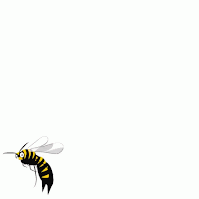If you are in certain parts of the US, I don’t have to tell you about the Brood X (Magicicada cassinii) cicada infestation that is currently happening – you’ve seen and heard it by now. With billions of insects emerging and their mating songs reaching up to 100 decibels, there’s just no missing this natural phenomenon. With all the attention that these loud, lovelorn insects are getting, this seems like a good time to introduce to both the cicada-addled and cicada-ignorant to a fascinating creature known as the Cicada Killer Wasp.
There are five native species of Cicada Killer Wasps in the Americas (Sphecius spp), with the most widespread being the Eastern Cicada Killer (Sphecius speciosus). But, before I go any further I want to clarify something about these insects: Yes, they prey on cicadas. But, no, they will not help put an end to the cicada invasion happening right now. The reason for this is simple: Cicada Killer Wasps emerge in July and August to coincide with the hatching of their only prey, the annual-cycle cicadas. By that point in the summer, the Magicicada cassinii cicadas have completed their 5–6-week life span. But this does not mean that there is never an overlap and, if there is, Cicada Killer Wasps will happily prey on any Magicicada cassinii stragglers they come across.
Cicada Killer Wasps are similar to other predatory wasps in that they parasitize insect prey to use as food for their larvae. As soon as the females emerge and mate, they get right to work digging burrows for their forthcoming offspring; they can construct an impressive underground system within a few hours. Once that task is complete, they go in search of a cicada. When the hapless cicada is located, the female will paralyze it with a sting (which causes it to emit a particularly loud and screeching buzz) and drags it back to her burrow. This part can take quite a bit of work, as the unresponsive cicadas are much bigger than the wasp and quite unwieldy. When she eventually gets the cicada home, she places an egg under one of its arms and closes up the burrow and creates what is now a cicada tomb and wasp hatchery. The egg will hatch a few days later and begin to feed on the cicada, taking care it keep it alive and fresh as long as possible. Once the cicada is used up, the larvae will make a cocoon over everything and overwinter in their burrow. Adults will have fulfilled their reproductive purpose and be gone by mid-September. To see how these wasps handle cicadas, check out this video.
 |
| Female busily burrowing |
The biggest problem for Cicada Killer Wasps is their size (up to 2”), which is scary for many people, and the fact that they are mistaken for Murder Hornets (Asian Giant Hornets) and other dangerous stinging wasps. The media has really latched onto the Murder Hornet thing and now people everywhere are fearful of them, but the reality is they are still only located in a small area in the Pacific Northwest. For the most part, what people are reporting as the bogey-man wasp are gentle native Cicada Killer Wasps, because the latter looks a great deal like the former. Which leads to senseless demonization and destruction of an innocent species and a lot of needless, frantic calls to the authorities. The problem has gotten bad enough that scientists in Texas are producing public service messages in an effort to slow the confusion.
While you are out there this summer listening to the deafening sound of billions of cicada calls or the soothing chirp of a few, keep an eye out for a particular black and yellow wasp. For her, those sounds are the dinner bell for her children.
Take Care.
Submitted by Pam










No comments:
Post a Comment